The AMD Radeon RX 590 Review, feat. XFX & PowerColor: Polaris Returns (Again)
by Nate Oh on November 15, 2018 9:00 AM ESTMeet The Cards: XFX & PowerColor
As there are no reference cards, for today's launch AMD sampled us the XFX Radeon RX 590 Fatboy. PowerColor also sampled us their RX 590 Red Devil. Both sport modest factory overclocks over the reference 1545MHz boost, and both feature dual BIOS with performance and quiet options. Broadly-speaking, if you're already familiar with PowerColor's Red Devil and XFX's GTS designs for Polaris, then you'll already know what these boards are like.
| Radeon RX 590 Series Cards | ||||||
| XFX RX 590 Fatboy | PowerColor RX 590 Red Devil | Radeon RX 590 (Reference) | Radeon RX 580 (Reference) |
|||
| Boost Clock | 1580MHz | 1576MHz | 1545MHz | 1340MHz | ||
| Memory Clock | 8Gbps | 8Gbps | 8Gbps | 8Gbps | ||
| VRAM | 8GB | 8GB | 8GB | 8GB | ||
| TBP | TBA | TBA | 225W | 185W | ||
| Length | 10.63" | 10" | N/A | N/A | ||
| Width | 2.5 Slot | 2.5 Slot | N/A | N/A | ||
| Cooler Type | Open Air | Open Air | N/A | N/A | ||
| Price | TBA | ~$299? | $279 | $229 | ||
Both of the cards are relatively typical for custom factory overclocked designs, featuring thick heatsinks, dual axial fans, 1x8pin + 1x6pin for power, and the extremely essential presence of LEDs. Right now we don't have a definitive answer on price, but expect them to be in the high $200s to low $300s range where heavily factory-overclocked GTX 1060 6GB cards reside. For the opening launch window, all the partner cards are marked at the $279 SEP.
XFX Radeon RX 590 Fatboy
From the outside, the XFX Radeon RX 590 Fatboy looks to be much of the same with its existing RX 500 and 400 series models. The card's amusing namesake comes from the new heatsink design that XFX is calling the 'Fatboy Unibody VRM Heatsink,' and the company claims the design brings 50% greater heatsink surface area over previous RX 400/500 series cards. So it would seem it's an iteration on the Unibody VRM Heatsink introduced by RX RS and GTR series cards.
As silly as the 'Fatboy' name may be, it seems to have done its marketing job by raising interest, critical or otherwise, and for a subdued Polaris refresh SKU, that extra differentiation can be helpful.
And in terms of 'fatness', the RX 590 Fatboy has the 2.5 slot Double Dissapation style cooler, leading up to a height of 2.09". Thick, but perhaps not as thick as the Red Devil, which stands at 2.24". In any case, the card is neatly clad in an aluminum backplate. Right next to the PCIe power connections is the BIOS dip switch, toggling between Performance and Quiet/Lower RPM.
The display output situation is fairly standard for both cards, with 3 DisplayPorts, 1 HDMI, and 1 DL-DVI-D port.
PowerColor Red Devil Radeon RX 590
For the Red Devil RX 590, the thermal solution doesn't appear unchanged from the RX 580 version, sharing the same dimensions, 4x8mm + 1x6mm heatpipes, 6+1 power phases, and DrMos. At 10" long but 2.24" (57mm) high, the Red Devil RX 590 is a particuarly squat but thick card - just 3mm away from the standard triple-slot width. So prospective buyers should keep that in mind for smaller form factors, occupied neighboring PCIe slots, or chassis airflow management.
While the card has the red Red Devil LED, one of the more easily overlooked features is a small dip switch to disable LEDs. Both BIOS and LED switches are labelled so on the pentagram-emblazoned 1.5mm metal backplate.
Both the XFX Fatboy and PowerColor Red Devil have zero dB fan functionality as well, turning off the fans under certain temperatures and lighter workloads.


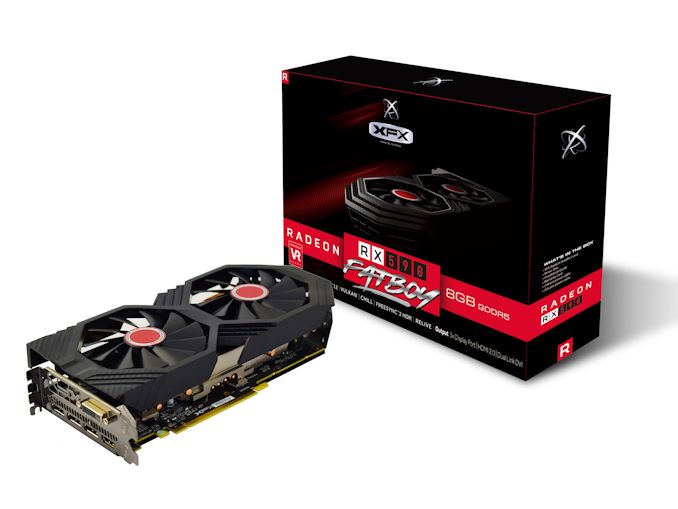
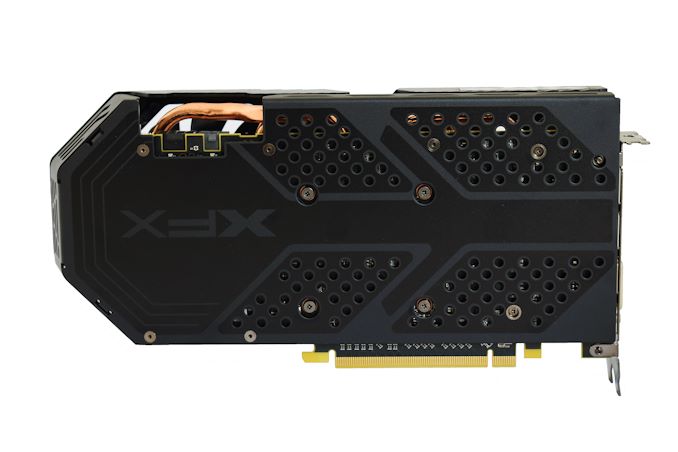
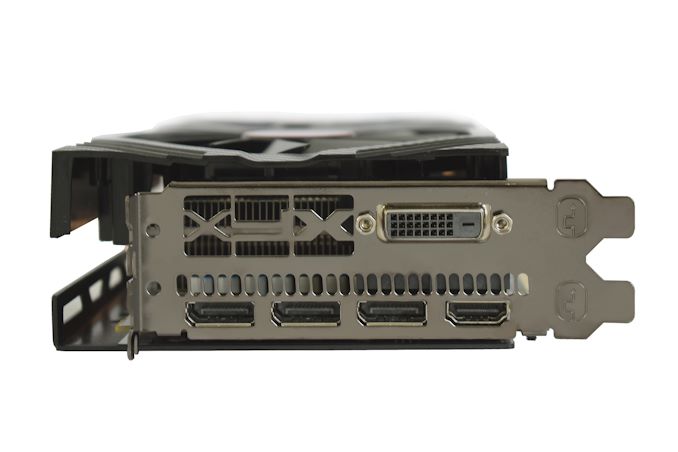
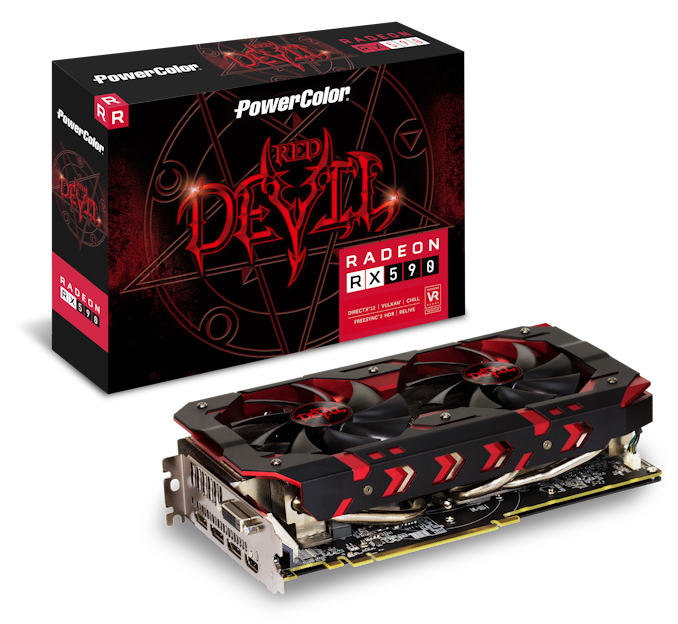
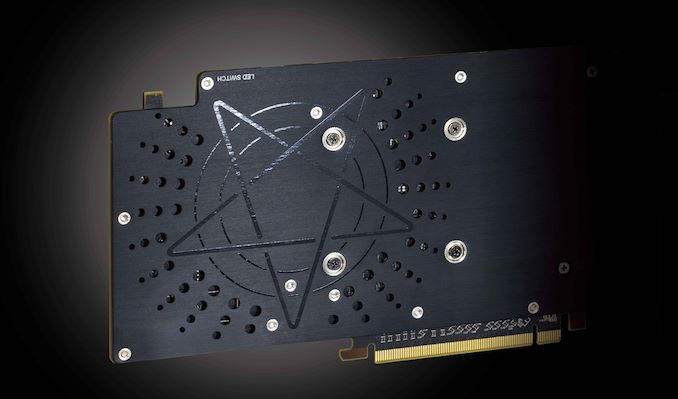








136 Comments
View All Comments
Kriswithak - Thursday, November 15, 2018 - link
I would love to see if the improved process offers better efficiency.With the RX480 4gb, I undervolted the card and saw a significant decrease in load power consumption.
With the RX580 8gb, I dropped the boost clocks a bit and dropped the voltage as well, and only used 6 pin power connector.
I would like to see the rx590/580/480 at similar reference/boost clocks, then undervolted to lowest possible stable and see what the frame per watt comparison is.
Nfarce - Thursday, November 15, 2018 - link
Just another example of AMD shooting their R&D wad at the APU/CPU segment and ignoring the GPU segment. There is ZERO reason to buy this fail over Nivdia unless you have already bought a Freesync monitor and a much older AMD GPU, which monitors, by the way, do work with Nvidia GPUs when locking down the v-sync tool. I have a Freesync 75Hz monitor ( 32" 1440p AOC) and love it with my GTX 1070 Ti locking in frames (bought it for $369 on NewEgg in a promo sale). Said 1070 Ti doesn't even need to breathe hard. Minimum FPS never comes close to hitting 75 FPS. Not only is it 30+% faster, but it also consumes nearly 20% less power under load than this card. Yeah, that's worth the extra $80 for my 1070 Ti in my book. You get what you pay for. I really hope AMD starts using some of their Ryzen revenue that they've been taking in for - nearly three years now mind you and not including their revenue stream from game console APUs - into upping their dedicated GPU game. Because they have a long way to go to match Nvidia in the upper tiers where the real price margin revenue is made. Nobody makes money on low and mid range GPUs where AMD has always targeted.eva02langley - Friday, November 16, 2018 - link
You are missing the point here, Lisa Su said that decision are took 3-5 years in advance for their roadmap.Polaris was already a thing and just making a 12 nm was an easy thing to do and was filling a gap.
People tend to forget that the 8GB RX 580 MSRP is actually 240$, not 200$ which is for the 4GB version. 30$ more is not such a step and still the cost per FPS is one of the lowest.
With a 100$+ of game bundle to add to it, there is no question that the value is there.
Flunk - Thursday, November 15, 2018 - link
Slightly overclocked RX 480 from two years ago? Wake me when AMD actually releases a new GPU.Cyborg997 - Thursday, November 15, 2018 - link
Can't believe this s*** with an AMD. 3 years with the same chips. What the f*** please give us something worth our money. Still have my Fury 9 runningAssimilator87 - Friday, November 16, 2018 - link
While everyone upped their resolution to UHD, I went the opposite direction and am running a CRT at 720p. My 7970's still running strong lol. CPU market is fire right now, but GPUs so boring =\piroroadkill - Friday, November 16, 2018 - link
So it sits somewhere between the 1060 6GB and 1070, most of the time closer to the former, and yet consumes a lot more power than either card. No thanks. People don't want noisy, hot systems these days without actually getting some performance to back it up.eva02langley - Friday, November 16, 2018 - link
It is actually quieter... check higher... seriously... people.Lolimaster - Friday, November 16, 2018 - link
It's really sad that 2 years after, performance per dollar went down.2 years more and we will have an APU with similar power than the RX580 on a $150 chip...
ItsAlive - Friday, November 16, 2018 - link
Now undervolt and overclock that gtx 1060, Mine was able to drop over 100mv, lowered power limit to 75%, but still overclocked 200/400 core/mem clocks and uses 75w max at full load. Temps typically run mid 60s with stock fan settings and its near silent. Its a mini card that is probably 1/3 the size of the RX590 and I bought it over a year ago for $250.If a stock gtx1060 uses typcially 120 watts max (mine would before the undervolt), then total system power for an undervolted card according to the charts in the article would look like this:
GTX1060/RX590/Fatboy
--------------------------------
BF1: 210w/363w/379w
Furmark: 206w/330w/362w
I would be interested to see an undervolted RX590 vs undervolted GTX1060 for a better comparison.